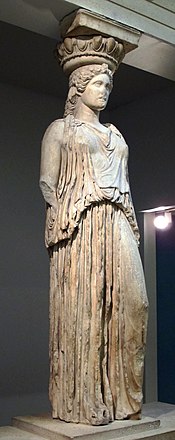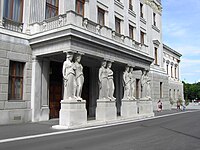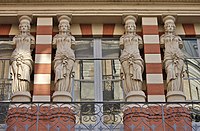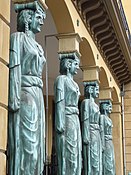Atlas Got Old Again Lost Fountain Buff


A caryatid ( KARR-ee-AT-id; Ancient Greek: Καρυάτις, pl. Καρυάτιδες ) is a sculpted female figure serving as an architectural support taking the identify of a column or a pillar supporting an entablature on her head. The Greek term karyatides literally ways "maidens of Karyai", an aboriginal town on the Peloponnese. Karyai had a temple dedicated to the goddess Artemis in her attribute of Artemis Karyatis: "As Karyatis she rejoiced in the dances of the nut-tree village of Karyai, those Karyatides, who in their ecstatic round-dance carried on their heads baskets of live reeds, every bit if they were dancing plants".[1]
An atlas or telamon is a male version of a brace, i.e. a sculpted male person statue serving every bit an architectural support.
Etymology [edit]
The origins of the term are unclear. It is first recorded in the Latin grade caryatides by the Roman builder Vitruvius. He stated in his 1st century BC work De architectura (I.ane.5) that the female figures of the Erechtheion represented the punishment of the women of Caryae, a boondocks near Sparta in Laconia, who were condemned to slavery after betraying Athens by siding with Persia in the Greco-Persian Wars. All the same, Vitruvius' caption is doubtful; well before the Western farsi Wars, female person figures were used every bit decorative supports in Greece[two] and the aboriginal Near East. Whatever the origin may have been, the clan of caryatids with slavery persists and is prevalent in Renaissance fine art.[3]
The ancient Caryae supposedly was one of the six adjacent villages that united to form the original township of Sparta, and the hometown of Menelaos' queen, Helen of Troy. Girls from Caryae were considered especially beautiful, strong, and capable of giving nascency to strong children.[ citation needed ]
A caryatid supporting a basket on her caput is called a canephora ("handbasket-bearer"), representing one of the maidens who carried sacred objects used at feasts of the goddesses Athena and Artemis. The Erectheion caryatids, in a shrine dedicated to an archaic king of Athens, may therefore represent priestesses of Artemis in Caryae, a place named for the "nut-tree sisterhood" – apparently in Mycenaean times, similar other plural feminine toponyms, such equally Hyrai or Athens itself.
The later male person counterpart of the caryatid is referred to every bit a telamon (plural telamones) or atlas (plural atlantes) – the proper noun refers to the legend of Atlas, who diameter the sphere of the heavens on his shoulders. Such figures were used on a monumental calibration, notably in the Temple of Olympian Zeus in Agrigento, Sicily.
Aboriginal usage [edit]

Some of the earliest known examples were found in the treasuries of Delphi, including that of Siphnos, dating to the 6th century BC. All the same, their use equally supports in the form of women tin be traced back even earlier, to ritual basins, ivory mirror handles from Phoenicia, and draped figures from primitive Hellenic republic.
The best-known and most-copied examples are those of the vi figures of the Brace porch of the Erechtheion on the Acropolis at Athens. Ane of those original vi figures, removed past Lord Elgin in the early 19th century, is now in the British Museum in London. The Acropolis Museum holds the other v figures, which are replaced onsite past replicas. The five originals that are in Athens are at present beingness exhibited in the new Acropolis Museum, on a special balcony that allows visitors to view them from all sides. The pedestal for the caryatid removed to London remains empty. From 2011 to 2015, they were cleaned by a particularly synthetic laser axle, which removed accumulated soot and grime without harming the marble's patina. Each caryatid was cleaned in place, with a television circuit relaying the spectacle live to museum visitors.[4]
Although of the same peak and build, and similarly attired and coiffed, the six Caryatids are not the same: their faces, opinion, draping, and hair are carved separately; the three on the left stand on their right foot, while the 3 on the correct stand on their left foot. Their bulky, intricately bundled hairstyles serve the crucial purpose of providing static support to their necks, which would otherwise exist the thinnest and structurally weakest role.
The Romans too copied the Erechtheion caryatids, installing copies in the Forum of Augustus and the Pantheon in Rome, and at Hadrian'southward Villa at Tivoli. Another Roman example, found on the Via Appia, is the Townley Caryatid.[v]
Renaissance and later [edit]
In Early Mod times, the practise of integrating caryatids into edifice facades was revived, and in interiors they began to exist employed in fireplaces, which had not been a feature of buildings in Antiquity and offered no precedents. Early interior examples are the figures of Heracles and Iole carved on the jambs of a monumental fireplace in the Sala della Jole of the Doge's Palace, Venice, about 1450.[half-dozen] In the following century Jacopo Sansovino, both sculptor and builder, carved a pair of female figures supporting the shelf of a marble chimneypiece at Villa Garzoni, near Padua.[seven] No architect mentioned the device until 1615, when Palladio's pupil Vincenzo Scamozzi included a affiliate devoted to chimneypieces in his Idea della archittura universale. Those in the apartments of princes and important personages, he considered, might be thousand enough for chimneypieces with caryatid supporters, such as one he illustrated and a similar one he installed in the Sala dell'Anticollegio, too in the Doge's Palace.[viii]

In the 16th century, from the examples engraved for Sebastiano Serlio's treatise on compages, caryatids became a fixture in the decorative vocabulary of Northern Mannerism expressed by the Fontainebleau Schoolhouse and the engravers of designs in Antwerp. In the early 17th century, interior examples appear in Jacobean interiors in England; in Scotland the overmantel in the bully hall of Muchalls Castle remains an early case. Caryatids remained part of the High german Bizarre vocabulary and were refashioned in more than restrained and "Grecian" forms past neoclassical architects and designers, such as the four terra cotta caryatids on the porch of St Pancras New Church, London (1822).
Many caryatids lined up on the facade of the 1893 Palace of the Arts housing the Museum of Science and Industry in Chicago. In the arts of design, the draped effigy supporting an acanthus-grown basket capital taking the form of a candlestick or a table-back up is a familiar cliche of neoclassical decorative arts. The John and Mable Ringling Museum of Art in Sarasota has caryatids as a motif on its eastern facade.

In 1905 American sculptor Augustus Saint Gaudens created a caryatid porch for the Albright–Knox Art Gallery in Buffalo, New York in which 4 of the eight figures (the other four figures holding simply wreaths) represented a unlike art form, Architecture, Painting, Sculpture, and Music.[9]
Auguste Rodin's 1881 sculpture Fallen Caryatid Carrying her Stone (part of his monumental The Gates of Hell piece of work)[ten] shows a fallen brace. Robert Heinlein described this slice in Stranger in a Strange State: "At present here we accept some other emotional symbol... for near three thousand years or longer, architects have designed buildings with columns shaped as female figures... After all those centuries it took Rodin to meet that this was piece of work too heavy for a girl... Here is this poor piddling caryatid who has tried—and failed, fallen under the load.... She didn't give upwards, Ben; she'due south still trying to lift that stone afterwards it has crushed her..."[11]
In Act 2 of his 1953 play 'Waiting for Godot', author Samuel Beckett has Estragon say "We are not caryatids!" when he and Vladimir tire of "cart(ing) around" the recently blinded Pozzo.
Agnes Varda made two short films documenting Caryatid columns around Paris. 1984 Les Dites Cariatides 2005 Les Dites Cariatides Bis.
The musical grouping Son Volt evoke the caryatides and their burden borne in poetic metaphor on the song "Caryatid Piece of cake" from their 1997 album Straightaways, with vocalizer Jay Farrar reproving an unidentified lover with the line "you play the caryatid easy."
Gallery [edit]
-

-

-

-

Victorian caryatids on an Edinburgh department store
-

Caryatids of a Wallace fountain from Paris
-
-
-

White terra cotta caryatids, Virebent manufacturing plant (Toulouse), 1830s.
Meet besides [edit]
- Caryatid stools in African fine art
- Term (architecture)
- The Sphere: Große Kugelkaryatide (Great Spherical Caryatid) – WTC sculpture by Fritz Koenig
References [edit]
- ^ (Kerenyi 1980 p 149)
- ^ Hersey, George, The Lost Meaning of Classical Architecture, MIT Printing, Cambridge, MA, 1998 p. 69
- ^ The Slave in European Fine art: From Renaissance Trophies to Abolitionist Emblem, ed Elizabeth Mcgrath and Jean Michel Massing, London (The Warburg Institute) 2012
- ^ Alderman, Liz (seven July 2014). "Acropolis Maidens Glow Anew". The New York Times . Retrieved 9 July 2014.
- ^ A. H. Smith, "Gavin Hamilton'southward Letters to Charles Townley" The Journal of Hellenic Studies 21 (1901: 306–321) p. 306 annotation three. Townley inventories, where it is interpolated betwixt No. ix (Hecate) and No. x (Fortune).
- ^ Noted past James Parker, in describing the precedents for the white marble brace chimneypiece from Chesterfield House, Westminster, now at the Metropolitan Museum of Art (Parker, "'Designed in the Most Elegant Manner, and Wrought in the Best Marbles': The Caryatid Chimney Piece from Chesterfield House", The Metropolitan Museum of Art Message, New Serial, 21.vi [February 1963] pp. 202–213).
- ^ Also noted past Parker 1963:206.
- ^ Both remarked upon by Parker 1963:206, and fig. ix.
- ^ "archsculptbooks.com". Archived from the original on vii July 2011. Retrieved 29 Dec 2016.
- ^ "Fallen Caryatid Carrying Her Stone". The Collection Online. Metropolitan Museum of Art. Retrieved January 29, 2015.
- ^ Heinlein, Robert A. (1961). Stranger in a Strange Land. Putnam. ISBN978-0-441-79034-0.
External links [edit]
| | Wikimedia Commons has media related to Caryatids. |
- Kerényi, Karl (1951) 1980. The Gods of the Greeks (Thames & Hudson)
- Conserving the Caryatids in the Acropolis Museum
- Images of Caryatids of Athens (Spanish)
- Cariatides room of the Louvre on YouTube
Atlas Got Old Again Lost Fountain Buff
Source: https://en.wikipedia.org/wiki/Caryatid

